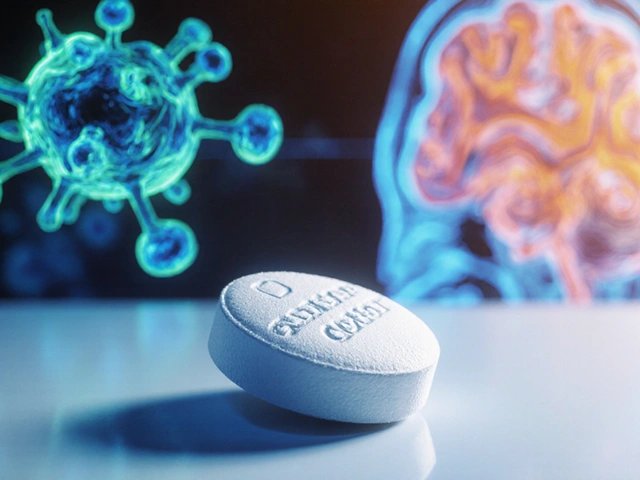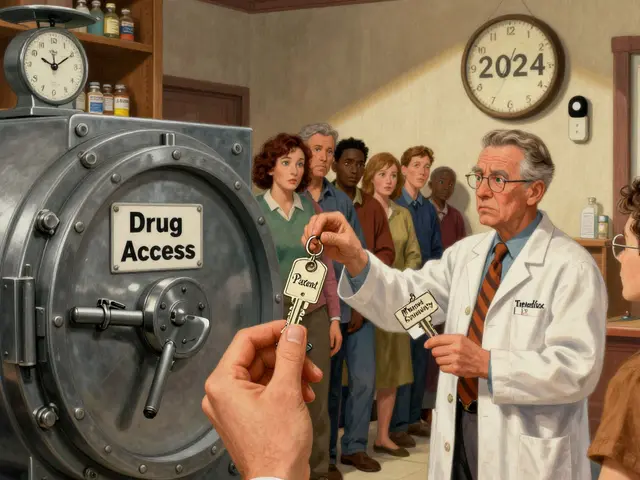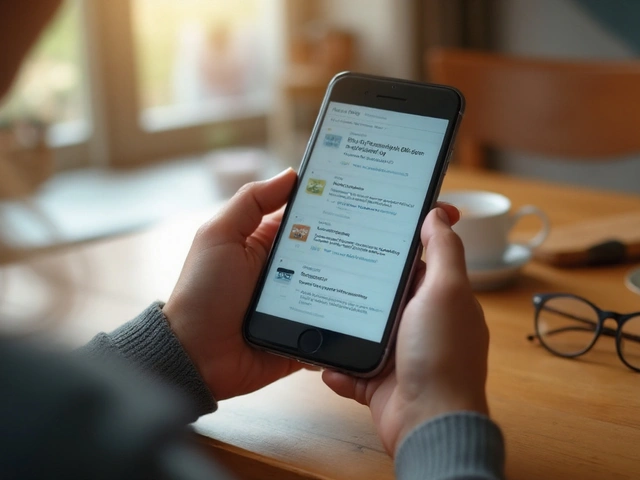BPH Symptom Tracker
BPH Symptom Assessment
Complete the AUA Symptom Score questionnaire to understand your BPH severity. Scores range from 0 (no symptoms) to 35 (severe symptoms). A drop of 3 points or more after 4-6 weeks usually signals meaningful improvement.
What Your Score Means:
Living with an enlarged prostate can turn everyday trips to the bathroom into a guessing game. The good news? alfuzosin offers a simple, once‑daily pill that eases those annoying urinary symptoms for many men. But like any medication, it works best when you know the right dose, timing, and safety tricks. Below is a no‑nonsense walk‑through that helps you get the most out of alfuzosin while steering clear of pitfalls.
Understanding BPH and How Alfuzosin Works
Benign Prostatic Hyperplasia is a non‑cancerous enlargement of the prostate gland that commonly appears after age 50. As the gland swells, it squeezes the urethra and triggers lower urinary tract symptoms (LUTS) like frequent urges, weak stream, and nighttime trips.
Alfuzosin belongs to the Alpha‑1 blockers, a class of drugs that relax smooth muscle in the prostate and bladder neck. By blocking alpha‑1 receptors, the medication reduces the tension that blocks urine flow, letting the bladder empty more easily.
Think of it as a gentle traffic officer who eases the bottleneck at a busy intersection. The result is smoother, faster passage without changing the size of the prostate itself.
Choosing the Right Dosage: When and How to Take Alfuzosin
The standard adult dose in the UK and many other regions is 10 mg taken once a day. You should swallow the tablet whole with a full glass of water - don’t crush or chew it, as that can affect how the drug is released.
Timing matters. Taking alfuzosin after the same meal each day (usually after breakfast) helps maintain steady blood levels and reduces the chance of dizziness, which tends to be worse on an empty stomach.
If you miss a dose, take it as soon as you remember - but never double‑up. A double dose can spike blood pressure drops, leading to light‑headedness or fainting.
Managing Safety: Common Side Effects & What to Watch For
Most men experience mild side effects that fade after a week or two. The most frequent ones include:
- Headache (up to 15% of users)
- Dizziness or feeling faint, especially when standing quickly
- Runny nose or nasal congestion
- Weakness or fatigue
If any of these linger beyond a fortnight, or if you notice trouble breathing, swelling of the face or lips, or a rapid heartbeat, call your doctor right away - these could signal a rare allergic reaction.

Drug Interactions: What to Avoid While on Alfuzosin
Alfuzosin is metabolised mainly by the liver enzyme CYP3A4 inhibitors. Medications that block this enzyme can raise alfuzosin levels, increasing dizziness and low‑blood‑pressure risks.
Common CYP3A4 inhibitors include:
- Erythromycin and clarithromycin (antibiotics)
- Ketoconazole and itraconazole (antifungals)
- Ritonavir (HIV protease inhibitor)
- Some calcium‑channel blockers like verapamil
If you’re prescribed any of these, your doctor may lower the alfuzosin dose or pick a different alpha‑blocker.
Other drugs that can amplify blood‑pressure drops include other alpha‑blockers (e.g., tamsulosin, doxazosin) and antihypertensives such as ACE inhibitors or beta‑blockers. Always let your pharmacist know every prescription and over‑the‑counter product you’re taking.
Monitoring Progress: How to Know It’s Working
Doctors often use the American Urological Association (AUA) Symptom Score to track BPH severity. The score runs from 0 (no symptoms) to 35 (severe). A drop of 3 points or more after 4‑6 weeks usually signals a meaningful improvement.
Objective tests can also help:
- Uroflowmetry measures the speed of urine flow - faster rates post‑treatment are a good sign.
- Prostate‑specific antigen (PSA) levels aren’t directly affected by alfuzosin, but regular PSA checks can rule out other prostate issues.
Schedule a follow‑up visit after the first month. Your clinician will note symptom changes, check blood pressure, and ensure you aren’t experiencing hidden side effects.
Practical Tips for Everyday Use
- Take the tablet with food, preferably after breakfast, to steady absorption.
- Stand up slowly from sitting or lying positions to avoid sudden dizziness.
- Stay hydrated, but avoid excessive fluid intake right before bedtime to reduce nocturia.
- If you have a history of low blood pressure, inform your doctor; a lower starting dose (5 mg) may be suggested.
- Keep a simple symptom diary - note morning and evening stream strength, frequency, and any side effects. This data makes doctor visits more productive.

When Alfuzosin Might Not Be Right for You
Alfuzosin isn’t suitable for everyone. Contraindications include:
- Severe liver disease (the drug is processed mainly by the liver)
- History of orthostatic hypotension that hasn’t been well‑controlled
- Known hypersensitivity to alfuzosin or any component of the tablet
In these cases, alternatives such as Tamsulosin or 5‑alpha‑reductase inhibitors like finasteride may be better choices.
Quick Reference Checklist
| Aspect | Alfuzosin (10 mg) | Tamsulosin (0.4 mg) | Doxazosin (4 mg) |
|---|---|---|---|
| Typical Use | Once daily after breakfast | Once daily after dinner | Once daily in the morning |
| Key Benefit | Low risk of ejaculation disorders | Effective for nocturia | Also lowers blood pressure |
| Common Side Effects | Headache, dizziness, nasal congestion | Dizziness, retrograde ejaculation (5‑10%) | Dizziness, fatigue, hypotension |
| Major Drug Interactions | CYP3A4 inhibitors (e.g., erythromycin) | CYP3A4 inhibitors, strong CYP2D6 inhibitors | Potent CYP3A4 inhibitors, antihypertensives |
| Contraindications | Severe liver disease, uncontrolled orthostatic hypotension | Severe hepatic impairment, hypersensitivity | Severe liver disease, hypotension |
Frequently Asked Questions
How long does it take for alfuzosin to start working?
Most men notice a reduction in urinary urgency and a stronger stream within 2‑4 weeks, but full benefit can take up to 8 weeks.
Can I drink alcohol while on alfuzosin?
Moderate alcohol is generally safe, but heavy drinking can amplify dizziness and low‑blood‑pressure effects, so limit intake.
Is it okay to take alfuzosin if I already use blood‑pressure medication?
Yes, but your doctor should monitor blood pressure closely. Sometimes the dose of the antihypertensive is lowered.
What should I do if I feel dizzy after the first dose?
Sit or lie down until it passes, then get up slowly. If dizziness persists beyond a few days, contact your clinician.
Can alfuzosin shrink my prostate?
No. Alfuzosin only relaxes muscle tone. If you need a drug that reduces prostate size, a 5‑alpha‑reductase inhibitor like finasteride is required.






Comments
jessie cole
20/Oct/2025Congratulations on taking a proactive step toward managing BPH; understanding alfuzosin is the cornerstone of successful treatment.
By adhering to the recommended 10 mg dose each morning with food, you set the stage for steady plasma levels and minimize dizziness.
Keep a simple diary of nighttime trips and stream strength; the data will speak louder than any anecdote when you meet your urologist.
Should you notice persistent headaches or faintness beyond two weeks, reach out promptly-early intervention prevents larger setbacks.
Stay disciplined, stay hydrated, and trust the process; the journey to smoother mornings begins with disciplined daily habits.
Matthew Hall
20/Oct/2025It seems the pharma giants want us to believe a single pill can fix everything, while they hide the real risks behind glossy brochures.
Take heed that hidden drug interactions could be the silent players pulling strings on your blood pressure.
Read the fine print, question the “once‑daily” narrative, and stay vigilant.
Demetri Huyler
20/Oct/2025While the article presents a surgeon's lullaby, the pharmacodynamics deserve a more rigorous dissection.
The selectivity of alfuzosin for α1‑A receptors distinguishes it from its contemporaries, reducing ejaculatory side effects-a nuance often glossed over by mainstream sources.
Moreover, the metabolic pathway via CYP3A4 imposes a non‑trivial constraint on polypharmacy that prescribers must not ignore.
Israel Emory
20/Oct/2025Indeed, the receptor specificity is a critical advantage, yet one must balance it against the potential for orthostatic hypotension, especially in patients with pre‑existing low‑pressure states,
and the timing of administration relative to meals can further modulate hemodynamic stability,
so a collaborative discussion between pharmacist and physician is paramount.
Sebastian Green
20/Oct/2025I understand how unsettling the occasional dizziness can feel; tracking those moments can really help your doctor fine‑tune the regimen.
Wesley Humble
20/Oct/2025The presented safety profile, while comprehensive, omits a quantitative risk assessment of concurrent antihypertensive agents.
Statistical analyses indicate a synergistic drop in systolic pressure up to 15 mmHg when alfuzosin is co‑administered with ACE inhibitors, a figure not reflected in the narrative.
Clinicians should therefore employ a calibrated monitoring protocol, perhaps utilizing ambulatory blood pressure monitoring for the first two weeks. 😊
barnabas jacob
20/Oct/2025Honestly, the moral imperative is to educate patients that alfuzosin isn’t a miracle cure; it’s merely a α‑blocker that tempers the muscle tone.
If you’re chasing a shrink‑the‑prostate fantasy, you’re misguided – consider 5‑α‑reductase inhibitors for volume reduction.
Don’t let pharma hype steer your health decisions.
Kirsten Youtsey
20/Oct/2025One cannot help but notice the omission of any discussion regarding the proprietary formulation’s excipients, which may harbor undisclosed allergens.
The silence on potential off‑label uses suggests a deliberate redirection of focus toward market‑friendly narratives.
Such gaps warrant a cautious approach.
Vijaypal Yadav
20/Oct/2025From a pharmacokinetic perspective, the half‑life of alfuzosin averages around 10 hours, which underpins the once‑daily dosing schedule; however, hepatic impairment can extend this significantly, necessitating dose adjustment.
Mahesh Upadhyay
20/Oct/2025Don’t be fooled by the “once daily” claim; any deviation in timing can precipitate a cascade of orthostatic events.
Rajesh Myadam
20/Oct/2025It can be reassuring to know that most side effects subside within a couple of weeks, but keeping an open line with your healthcare team ensures any lingering issues are addressed promptly.
Ron Lanham
20/Oct/2025First and foremost, the responsibility for safe medication use lies not only with prescribers but also with patients who must be vigilant about their own health data.
When you commence alfuzosin therapy, it is essential to establish a baseline blood pressure reading in both supine and standing positions, as even modest reductions can translate into significant dizziness for susceptible individuals.
Documenting the exact time of each dose, preferably after a consistent meal, allows you to correlate any adverse events with pharmacokinetic peaks.
Should you experience a headache persisting beyond three days, this may signal an inadequate response rather than a benign side effect, prompting a reassessment of the therapeutic plan.
Equally important is the observation of any nasal congestion that does not resolve, which could indicate an off‑target alpha‑1‑B receptor interaction.
Patients with concomitant antihypertensive therapy should schedule a follow‑up appointment within two weeks to evaluate potential additive hypotensive effects.
If you are on a CYP3A4 inhibitor such as erythromycin, inform your clinician promptly, as the resulting increase in alfuzosin plasma concentration can exacerbate orthostatic symptoms.
A simple self‑test involves rising slowly from a seated position; if light‑headedness occurs, sit back down and rest before attempting again.
Maintaining adequate hydration is advisable, yet excessive fluid intake close to bedtime should be avoided to reduce nocturnal polyuria.
Regularly updating a symptom diary with metrics such as nocturnal voids, stream strength, and urgency episodes can provide objective data for your physician.
In addition, periodic uroflowmetry, if available, offers quantitative confirmation of improved urinary flow rates.
Do not disregard the rare but serious allergic manifestations-face swelling, difficulty breathing, or rapid heartbeat warrant immediate medical attention.
For those with a history of severe liver disease, alternative agents should be considered, as hepatic metabolism is the primary clearance pathway for alfuzosin.
Ultimately, the goal is to achieve a balance where urinary symptoms are alleviated without compromising cardiovascular stability.
By adhering to these practical guidelines, you empower yourself to navigate the treatment journey with confidence and safety.
Deja Scott
20/Oct/2025The guide nicely bridges clinical detail with everyday language, making the information accessible without sacrificing accuracy.
Natalie Morgan
20/Oct/2025Keep tracking your progress and celebrate each small improvement-you’ve got this!